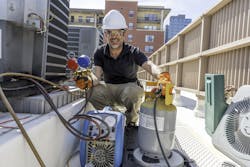Because many recently proposed regulatory changes to the HVACR industry are beginning to take effect, it’s a good idea to revisit the Three R’s of refrigerant management: Recovery. Reclaim. Recycle. While the world works toward circularity and resource efficiency —that is, getting the most out of every kilowatt of electricity used to run, or pound of material used to construct an HVACR system—an increased focus on strong refrigerant management is obviously needed as well.
An increase in reclaimed refrigerants will be needed to meet some of the resulting supply-demand gap.
When considering the various HFC phasedown rules, it becomes apparent that an increase in reclaimed refrigerants will be needed to meet some of the resulting supply-demand gap. And while service technicians have been at this game for years, now even the equipment manufacturers will need access to reclaimed gas in order to meet regulations in some areas.
Although they all may sound similar, the Three R’s mentioned above have important distinctions. According to ASHRAE, the definitions are as follows:
- Recovery—to remove refrigerant in any condition from a system and store it in an external container
- Recycle—to reduce contaminants in used refrigerant by separating oil, removing non-condensables, and using devices such as filter driers to reduce moisture, acidity, and particulate matter
- Reclaim—to process used refrigerant to new product specifications.*
Everyone in the industry will need to step up their recovery and reclaim efforts going forward. For service contractors, this starts with recovering every pound possible, both during maintenance as well as at end-of-life. In addition, while recycling gas or putting it back into a system owned by the same entity is allowed, finding a suitable reclaim program to maximize the value of recovered gas is advisable.
Now is a great time to consider refresher training on recovery best practices and safety.
Lastly, now is a great time to consider refresher training on recovery best practices and safety—such as safe fill weights, properly rated recovery machines, etc. This training will be key due to the increase in recovery/reclaim activities coming our way, including those for mildly flammable (2L) refrigerants such as R-454B replacing R-410A.
Reducing the environmental impact of our industry is something we all can—and should—do. Renewing our focus on refrigerant recovery, recycling, and reclaim is a great way to start the new year.
*Reclamation also involves analytical testing/certification of quality by officially certified reclaimers.
About the Author
Charles Allgood
Technical Fellow with Chemours
Charles “Dr. Chuck” Allgood holds a PhD in chemistry, has more than 30 years of experience in the HVACR industry, and is a respected speaker at many industry events. In addition to Chemours, he’s worked for the National Institute of Standards and Technology. Dr. Allgood has held a variety of research, development, business, technical service, training, and applications development positions with Chemours. Most recently, he has focused on the development of low-GWP refrigerants—including Chemours Opteon™ brand refrigerants—and educating industry professionals about the changing regulatory landscape and A2L refrigerants on the market.

